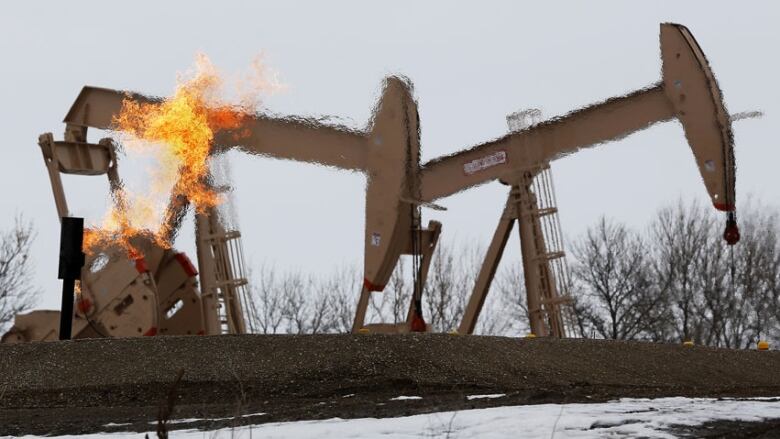Oil outlook grim amid continued supply glut
Analysts cut forecast for prices amid 'new oil order'

After sinking to its lowest level since March on Friday, oil prices bounced up slightly on Monday on news that China had imported record volumes of crude.
But analysts are already downgrading their long-term forecasts for crude prices, saying the demand-supply dynamic is changing.
- The world is awash in oil is Canada making it worse?
- World oil demand is up, but the glut remains, IEA says
On Monday, West Texas Intermediate, the most important North American contract, was at $44.80US a barrel at the close, up 93 cents on the day.It has declined by 20 per cent in the past month and was well below $44 on Friday.
Western Canada Select, an oilsands contract, looks even more lacklustre, trading at $31 a barrel on Monday on the prospect that the Keystone XL pipeline would fail to get U.S. approval. Repairs underway at BP's refinery in Whiting, Indiana, which processes heavy crude, also helped keep prices low.
On Saturday, figures from the Beijing-based General Administration of Customs showed a surge of oil imports to China, mainly by small refineries.
There were also reports that Algeria and Libya had asked for an early meeting of the Organization of Petroleum Exporting Countries, holding out hope that OPEC production targets might be cut back sooner than the currently scheduled meeting in December.
Not likely to recover
But longerterm, analysts sayit is looking less likely oil will bounce back in the second half of the year, a prospect the Canadian oilpatch had hoped for.
World demand for crude is rising, but it hasn't been enough to offset the oversupply.
TD Bank this morning downgraded its average oil price for the year to $55 US a barrel in the face of the continuing glutand a nuclear deal with Iran that could release still more oil into the market.
"Given the still-growing glut, oil prices will remain under pressure in the near term, unlikely to get back above the $60 US per barrel mark until 2016," TD said in its latest commodities outlook.
Several analysts have predicted even lower oil prices for later in the year, because of signs U.S. shale producers are stepping up production.
'New oil order'
Jeff Currie, global head of Commodities Research at Goldman Sachs, says there is a "new oil order" because of shale technology.
As the price of crude fell over the past year, shale producers have found ways to keep their costs low, Currie said.
"They can dial it up, dial it down in a very short time," Currie said.
In the past the oil sector has been dominated by large players such as BP and Exxon who took a long time to develop new oil projects, especially offshore projects, he said.
Now there are a lot of small players who are competitive at the low prices now being seen in the market.
So the news that new rigs were coming into play in the U.S. last week was not unexpected.
ConocoPhillips and Total have both predicted the cost of production for U.S. shale will fall 30 per cent this year, making production economical at below $60 US a barrel.
Oil supply and demand are seeking a new equilibrium, Currie said.
Reduction in output needed
There needs to be a real cut in production by U.S. shale producers to get supply in line with demand, according to Patricia Mohr, vice-president, economic and commodity market specialist at Scotiabank.
Many investors believed that cut was happening early this year, as the number of rigs in operation shrank, but in fact, the amount of crude produced in the U.S. continued to rise, she said in an interview with CBC News.
Mohr is optimistic the industry may make that adjustment this fall, with prices now below $50.
"That's not a level that's sustainable for too long when producers aren't earning enough to cover the cost of production," she said.
Today's low prices also reflect the weak industrial activity, and thus weak demand for oil, that's seen in the late summer every year.
"We're in the late summer and every August there is a marked slowdown in industrial activity,"she said. "In the late summer, commodity markets become very difficult to read."












_(720p).jpg)


 OFFICIAL HD MUSIC VIDEO.jpg)
.jpg)



























































































